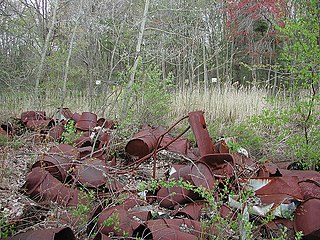Related Research Articles

The United States Army Corps of Engineers (USACE) is an engineer formation of the United States Army that has three primary mission areas: Engineer Regiment, military construction, and civil works. The day-to-day activities of the three mission areas are administered by a lieutenant general known as the commanding general/chief of engineers. The chief of engineers commands the Engineer Regiment, comprising combat engineer, rescue, construction, dive, and other specialty units, and answers directly to the Chief of Staff of the Army. Combat engineers, sometimes called sappers, form an integral part of the Army's combined arms team and are found in all Army service components: Regular Army, National Guard, and Army Reserve. Their duties are to breach obstacles; construct fighting positions, fixed/floating bridges, and obstacles and defensive positions; place and detonate explosives; conduct route clearance operations; emplace and detect landmines; and fight as provisional infantry when required. For the military construction mission, the commanding general is directed and supervised by the Assistant Secretary of the Army for installations, environment, and energy, whom the President appoints and the Senate confirms. Military construction relates to construction on military bases and worldwide installations.

Superfund is a United States federal environmental remediation program established by the Comprehensive Environmental Response, Compensation, and Liability Act of 1980 (CERCLA). The program is administered by the Environmental Protection Agency (EPA). The program is designed to investigate and clean up sites contaminated with hazardous substances. Sites managed under this program are referred to as "Superfund" sites. There are 40,000 federal Superfund sites across the country, and approximately 1,300 of those sites have been listed on the National Priorities List (NPL). Sites on the NPL are considered the most highly contaminated and undergo longer-term remedial investigation and remedial action (cleanups).

The Rocky Mountain Arsenal was a United States chemical weapons manufacturing center located in the Denver Metropolitan Area in Commerce City, Colorado. The site was completed December 1942, operated by the United States Army throughout the later 20th century and was controversial among local residents until its closure in 1992.

Camp Leach, formerly known as the American University Experimental Station and Camp American University, was a World War I era United States Army camp built by the Corps of Engineers on American University property in Washington, D.C. It was named in honor of Colonel Smith S. Leach, Corps of Engineers. The camp was established in 1917 for the organization of engineer units and subsequently used by the Chemical Warfare Service. Abandoned in January 1919, it was ordered salvaged.

The National Priorities List (NPL) is the priority list of hazardous waste sites in the United States eligible for long-term remedial investigation and remedial action (cleanup) financed under the federal Superfund program. Environmental Protection Agency (EPA) regulations outline a formal process for assessing hazardous waste sites and placing them on the NPL. The NPL is intended primarily to guide EPA in determining which sites are so contaminated as to warrant further investigation and significant cleanup.

In the United States, an environmental site assessment is a report prepared for a real estate holding that identifies potential or existing environmental contamination liabilities. The analysis, often called an ESA, typically addresses both the underlying land as well as physical improvements to the property. A proportion of contaminated sites are "brownfield sites." In severe cases, brownfield sites may be added to the National Priorities List where they will be subject to the U.S. Environmental Protection Agency's Superfund program.

The former Lake Ontario Ordnance Works (LOOW) was a 7,500-acre (3,000 ha) military installation located in Niagara County, New York, United States, approximately 9.6 mi (15.4 km) north of Niagara Falls.

West Virginia Ordnance Works (WVOW) was a United States Army ammunition manufacturing facility constructed and operated during World War II. It was located north of Point Pleasant, West Virginia in Mason County encompassing 8,323 acres (33.68 km2). The $45 million plant employed 3500 at its peak and operated from 1942 to 1945. The site was disposed of following the war and land was utilized by creating a landfill, the McClintic Wildlife Management Area, the Mason County Airport and an industrial park among others.
Diamond Alkali Company was an American chemical company incorporated in 1910 in West Virginia by a group of glass industry businessmen from Pittsburgh. The company soon established a large chemical plant at Fairport Harbor, Ohio, which would operate for over sixty years. In 1947, the headquarters of the company was moved from Pittsburgh to Cleveland. Later the company established a plant in Redwood City, California, that produced ion-exchange resins. In 1967, Diamond Alkali and Shamrock Oil and Gas merged to form the Diamond Shamrock Corporation. Diamond Shamrock would go on to merge with Ultramar Corporation, and the combined company, Ultramar Diamond Shamrock Corporation, would in turn be acquired by Valero Energy Corporation in 2001.
The West Virginia Maneuver Area (WVMA) was a vast, five-county training ground in the Allegheny Mountains of eastern West Virginia used by the U.S. Army during World War II to train soldiers in low-altitude mountain operations. This area was selected due to its similarity to the mountainous terrain of Italy and other areas within the European Theater of Operations.
The Formerly Utilized Sites Remedial Action Program (FUSRAP) is a United States Army Corps of Engineers (USACE) project to manage and cleanup environmental contamination that resulted from early United States Atomic Energy Commission activities. Cleanup activities were initially performed under the supervision of the United States Department of Energy (DOE), until 1997 when the United States Congress passed authority for cleanup activities to the USACE.

Shpack Landfill is a hazardous waste site in Norton, Massachusetts. After assessment by the United States Environmental Protection Agency (EPA) it was added to the National Priorities List in October 1986 for long-term remedial action. The site cleanup is directed by the federal Superfund program. The Superfund site covers 9.4 acres, mostly within Norton, with 3.4 acres in the adjoining city of Attleboro. The Norton site was operated as a landfill dump accepting domestic and industrial wastes, including low-level radioactive waste, between 1946 and 1965. The source of most of the radioactive waste, consisting of uranium and radium, was Metals and Controls Inc. which made enriched uranium fuel elements for the U.S. Navy under contract with the U.S. Atomic Energy Commission. Metals and Controls merged with Texas Instruments in 1959. The Shpack landfill operation was shut down by a court order in 1965.
The Capitol City Plume, which also is referred to as the Capital City Plume, is an area of contaminated groundwater located beneath the western downtown area of Montgomery, Alabama. The contamination was discovered in 1993 by the Alabama Department of Environmental Management (ADEM) which was investigating soil contamination at the Retirement Systems of Alabama Energy Plant in the city. After assessment by the United States Environmental Protection Agency (EPA) it was proposed for inclusion in the National Priorities List (NPL) in May 2000.
Camp Van Dorn is a former military installation in Centreville, Mississippi, in both Wilkinson and Amite counties. Established in 1942 during World War II, the base was named for Confederate General Earl Van Dorn from Mississippi. Holding up to 30,000 troops for training, it operated until 1946, after which it was declared surplus to government needs.
The Maywood Chemical Company processed radioactive thorium waste from 1916 through 1955 in Maywood / Rochelle Park, in Bergen County, New Jersey, United States. The United States Environmental Protection Agency (EPA) deemed Maywood Chemical a Superfund site in 1983 and has since been in the clean process.
A Restoration Advisory Board or RAB is a group, which meets on a regular basis to discuss environmental restoration at a US military installation currently or formerly used and owned by the US Department of Defense (DoD). These developed in the 1990s when DOD locally and nationally engaged people from communities impacted by military contamination. As of 2015, there were 229 RABs on 250 installations.

The Sharonville Engineer Depot was a facility constructed by the United States Army near Sharonville in Hamilton County, Ohio, United States, for the purpose of storage of strategic metals. The site was originally 642 acres in size.
References
- ↑ "Formerly Used Defense Sites". website. U.S. Army Corps of Engineers. n.d. Retrieved 13 May 2014.
- ↑ "FUDS". Fact sheet. U.S. Army Corps of Engineers. Retrieved 13 May 2014.
- ↑ Poirier, David R. (2001). Dangerous Places: Health, Safety, and Archaeology. Greenwood Publishing Group. pp. 170–171. ISBN 978-0-89789-801-0.
- ↑ Albright, Richard D. (2008). Cleanup of chemical and explosive munitions: locating, identifying contaminants, and planning for environmental remediation of land and sea military ranges and ordnance dumpsites. William Andrew. p. xix. ISBN 978-0-8155-1540-1.
- ↑ Mauroni, Albert J. (2003). Chemical demilitarization: public policy aspects. Greenwood Publishing Group. p. 136. ISBN 978-0-275-97796-2.
- ↑ "Environmental Quality FORMERLY USED DEFENSE SITES (FUDS) PROGRAM POLICY" (PDF). Engineer Regulation 200-3-1. U.S. Army Corps of Engineers. 10 May 2004. p. 297. Retrieved 13 May 2014.